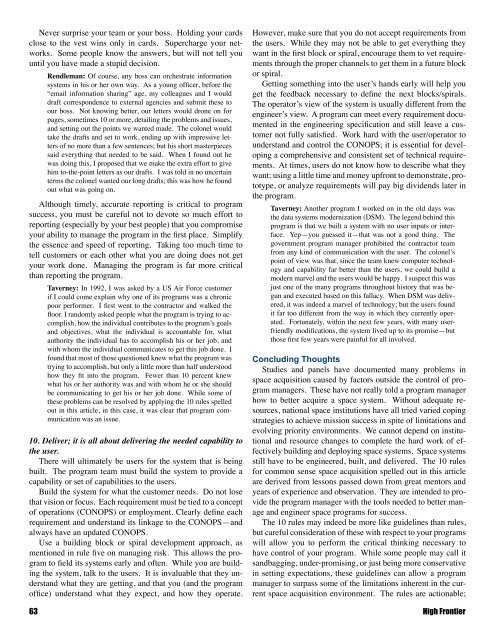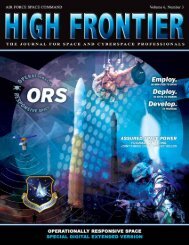Space Acquisition - Air Force Space Command
Space Acquisition - Air Force Space Command
Space Acquisition - Air Force Space Command
You also want an ePaper? Increase the reach of your titles
YUMPU automatically turns print PDFs into web optimized ePapers that Google loves.
Never surprise your team or your boss. Holding your cards<br />
close to the vest wins only in cards. Supercharge your networks.<br />
Some people know the answers, but will not tell you<br />
until you have made a stupid decision.<br />
Rendleman: Of course, any boss can orchestrate information<br />
systems in his or her own way. As a young officer, before the<br />
“email information sharing” age, my colleagues and I would<br />
draft correspondence to external agencies and submit these to<br />
our boss. Not knowing better, our letters would drone on for<br />
pages, sometimes 10 or more, detailing the problems and issues,<br />
and setting out the points we wanted made. The colonel would<br />
take the drafts and set to work, ending up with impressive letters<br />
of no more than a few sentences; but his short masterpieces<br />
said everything that needed to be said. When I found out he<br />
was doing this, I proposed that we make the extra effort to give<br />
him to-the-point letters as our drafts. I was told in no uncertain<br />
terms the colonel wanted our long drafts; this was how he found<br />
out what was going on.<br />
Although timely, accurate reporting is critical to program<br />
success, you must be careful not to devote so much effort to<br />
reporting (especially by your best people) that you compromise<br />
your ability to manage the program in the first place. Simplify<br />
the essence and speed of reporting. Taking too much time to<br />
tell customers or each other what you are doing does not get<br />
your work done. Managing the program is far more critical<br />
than reporting the program.<br />
Taverney: In 1992, I was asked by a US <strong>Air</strong> <strong>Force</strong> customer<br />
if I could come explain why one of its programs was a chronic<br />
poor performer. I first went to the contractor and walked the<br />
floor. I randomly asked people what the program is trying to accomplish,<br />
how the individual contributes to the program’s goals<br />
and objectives, what the individual is accountable for, what<br />
authority the individual has to accomplish his or her job, and<br />
with whom the individual communicates to get this job done. I<br />
found that most of those questioned knew what the program was<br />
trying to accomplish, but only a little more than half understood<br />
how they fit into the program. Fewer than 10 percent knew<br />
what his or her authority was and with whom he or she should<br />
be communicating to get his or her job done. While some of<br />
these problems can be resolved by applying the 10 rules spelled<br />
out in this article, in this case, it was clear that program communication<br />
was an issue.<br />
10. Deliver; it is all about delivering the needed capability to<br />
the user.<br />
There will ultimately be users for the system that is being<br />
built. The program team must build the system to provide a<br />
capability or set of capabilities to the users.<br />
Build the system for what the customer needs. Do not lose<br />
that vision or focus. Each requirement must be tied to a concept<br />
of operations (CONOPS) or employment. Clearly define each<br />
requirement and understand its linkage to the CONOPS—and<br />
always have an updated CONOPS.<br />
Use a building block or spiral development approach, as<br />
mentioned in rule five on managing risk. This allows the program<br />
to field its systems early and often. While you are building<br />
the system, talk to the users. It is invaluable that they understand<br />
what they are getting, and that you (and the program<br />
office) understand what they expect, and how they operate.<br />
However, make sure that you do not accept requirements from<br />
the users. While they may not be able to get everything they<br />
want in the first block or spiral, encourage them to vet requirements<br />
through the proper channels to get them in a future block<br />
or spiral.<br />
Getting something into the user’s hands early will help you<br />
get the feedback necessary to define the next blocks/spirals.<br />
The operator’s view of the system is usually different from the<br />
engineer’s view. A program can meet every requirement documented<br />
in the engineering specification and still leave a customer<br />
not fully satisfied. Work hard with the user/operator to<br />
understand and control the CONOPS; it is essential for developing<br />
a comprehensive and consistent set of technical requirements.<br />
At times, users do not know how to describe what they<br />
want; using a little time and money upfront to demonstrate, prototype,<br />
or analyze requirements will pay big dividends later in<br />
the program.<br />
Taverney: Another program I worked on in the old days was<br />
the data systems modernization (DSM). The legend behind this<br />
program is that we built a system with no user inputs or interface.<br />
Yep—you guessed it—that was not a good thing. The<br />
government program manager prohibited the contractor team<br />
from any kind of communication with the user. The colonel’s<br />
point of view was that, since the team knew computer technology<br />
and capability far better than the users, we could build a<br />
modern marvel and the users would be happy. I suspect this was<br />
just one of the many programs throughout history that was begun<br />
and executed based on this fallacy. When DSM was delivered,<br />
it was indeed a marvel of technology; but the users found<br />
it far too different from the way in which they currently operated.<br />
Fortunately, within the next few years, with many userfriendly<br />
modifications, the system lived up to its promise—but<br />
those first few years were painful for all involved.<br />
Concluding Thoughts<br />
Studies and panels have documented many problems in<br />
space acquisition caused by factors outside the control of program<br />
managers. These have not really told a program manager<br />
how to better acquire a space system. Without adequate resources,<br />
national space institutions have all tried varied coping<br />
strategies to achieve mission success in spite of limitations and<br />
evolving priority environments. We cannot depend on institutional<br />
and resource changes to complete the hard work of effectively<br />
building and deploying space systems. <strong>Space</strong> systems<br />
still have to be engineered, built, and delivered. The 10 rules<br />
for common sense space acquisition spelled out in this article<br />
are derived from lessons passed down from great mentors and<br />
years of experience and observation. They are intended to provide<br />
the program manager with the tools needed to better manage<br />
and engineer space programs for success.<br />
The 10 rules may indeed be more like guidelines than rules,<br />
but careful consideration of these with respect to your programs<br />
will allow you to perform the critical thinking necessary to<br />
have control of your program. While some people may call it<br />
sandbagging, under-promising, or just being more conservative<br />
in setting expectations, these guidelines can allow a program<br />
manager to surpass some of the limitations inherent in the current<br />
space acquisition environment. The rules are actionable;<br />
63 High Frontier











